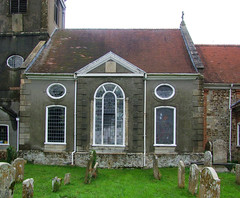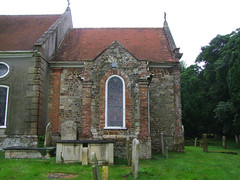
home I index I latest I glossary I introductions I e-mail I about this site
All Saints, North Runcton
Read
the captions by hovering over the images, and click on them to
see them enlarged.


| All
Saints, North Runcton It was a gloomy morning, and the parish of North Runcton was not about to lighten the mood. The church is one of East Anglia's few 18th Century rebuilds, necessarily so because, after long years of post-Reformation neglect, the tower fell and crashed into the nave in 1701. The replacement was built in a leisurely manner over a period of about ten years, the architect being Henry Bell, who, as Pevsner points out, rather conveniently lived in the parish. Perhaps he worked on it in his spare time. The exterior looks like what an early 18th Century idea of a replacement medieval church would look like, I suppose - the rebuilt nave and chancel are planned conventionally, although the nave is rendered in grey cement in the manner of stucco, with pedimented projections to north and south which would be quite at home in the City of London. The south extension from the chancel, which matches it very well, was in fact an addition of the 1890s to accomodate an organ. Pevsner
makes the building sound quite interesting inside, but
I'm afraid that I wouldn't know. The church is set beside
a polite, pretty village green with houses for company.
There is no reason on God's earth why the church can't be
open during the day, except that this is part of the
Middlewinch benefice of churches, for some of whom
welcoming the stranger within the gate, or giving
hospitality to pilgrims thereby entertaining angels
unawares, appears to be just something that some bloke
talked about in the Bible. You'd almost think they didn't really want us inside. And yet, as I have observed many times to the point of tedium, hardly anyone is going to make their first visit to a village church to attend a service. They are far more likely to wander in on their own during the week, testing the water so to speak, or perhaps to unburden themselves of a great grief or guilt, or simply to feel a sense of the eternal. They may not come back on Sunday - though, of course, they might - but the church has been there in their hour of need, to lift them up and carry them on. And then there are those who love the feel of a church without really knowing why, without thinking there is any spiritual dimension to their yearning. Perhaps it is because the church is a touchstone down the long parish generations, back to the ploughboy and the horseman, the swineherd and the miller. In a changing world, stepping into an empty church can give a feeling of the unchanging - no, not that exactly, more of the permanent ground around which time moves, the still point of the turning world, the place where our compulsions meet, are recognised and robed as destinies. And of course those people may come back on Sunday too. Now, it
may well be that North Runcton is a thriving parish, and
this church is packed to the gunwales three times every
Sunday. Indeed, perhaps they have no room to welcome the
tax collectors and sinners who might respond to the sense
of the numinous they'd find by wandering into this
building on their own, on a weekday. Perhaps they
actually don't need to be open as an act of witness to
strangers, pilgrims and those with a thirst for a sense
of the spiritual. Perhaps they actually do need to keep
us people out. |
Simon Knott, July 2016
Amazon commission helps cover the running costs of this site.
home I index I latest I introductions I e-mail I about this site I glossary
Norwich I ruined churches I round tower churches I links I small
print
www.simonknott.co.uk I www.suffolkchurches.co.uk